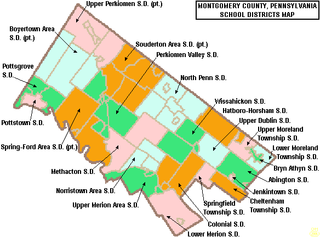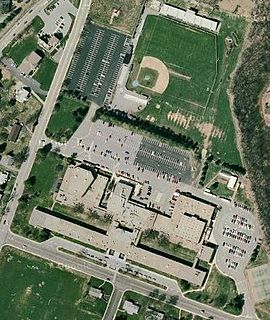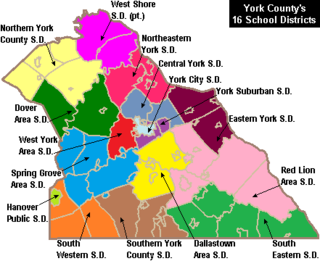Education in the United States of America is provided in public, private, and home schools. State governments set overall educational standards, often mandate standardized tests for K–12 public school systems and supervise, usually through a board of regents, state colleges, and universities. The bulk of the $1.3 trillion in funding comes from state and local governments, with federal funding accounting for only about $200 billion. Private schools are generally free to determine their own curriculum and staffing policies, with voluntary accreditation available through independent regional accreditation authorities, although some state regulation can apply.
Avonworth High School is a high school serving the northern boroughs and townships of the metro region of Pittsburgh, Pennsylvania. Neighborhoods served include Ben Avon, Ben Avon Heights and Emsworth, along with Ohio Township and Kilbuck Township.
The California High School Exit Examination (CAHSEE) was an examination created by the California Department of Education, that was previously mandated to administer in High Schools statewide in order to graduate. The examination was suspended in 2015, when Governor Jerry Brown signed a bill undoing the decade old requirement. It was originally created by the California Department of Education to improve the academic performance of California high school students, and especially of high school graduates, in the areas of reading, writing, and mathematics. In addition to other graduation requirements, public school students needed to pass the exam before they could receive a high school diploma.

Cedar Cliff High School is located in Camp Hill, Cumberland County, Pennsylvania, United States, and is older of the two high schools in the West Shore School District. It was formed in 1960 with the merger of West Shore High School and New Cumberland High School. The entire West Shore School District attended Cedar Cliff until fall 1965, when Red Land High School opened. In 2019, the school had 1,290 students enrolled. In 2011, the school had 95 teachers yielding a student teach ratio of 14:1. According to a 2011 report by the Pennsylvania Department of Education, eight teachers are considered "Non‐Highly Qualified" under No Child Left Behind law. The Cedar Cliff mascot is The Colt, and the school colors are navy blue, white and gold. The Pennsylvania Department of Education has set the tuition for non-resident and charter school students at $8,969.40.

McGuffey High School is one of four schools that make up the McGuffey School District in rural Claysville, Pennsylvania, located approximately 30 miles southwest of Pittsburgh. The school's official colors are navy blue and gold and "Highlanders" has been adopted as the official school nickname. The McGuffey High School building is jointly used by McGuffey Middle School. The school and the district are named for William Holmes McGuffey, author of the McGuffey Reader, who was born within the district boundaries.

Souderton Area High School is a large high school in the Montgomery County suburbs of Philadelphia located at 625 Lower Road in Souderton, Pennsylvania, United States, and serves residents in Souderton and Telford boroughs, and Franconia, Lower Salford and Upper Salford townships. It is the only high school in Souderton Area School District.
Scranton High School is an urban high school located in Lackawanna County, Scranton, Pennsylvania, United States. It is part of the Scranton School District. It enrolled 1,792 ninth through twelfth grade students in 2010. It is accredited by the Middle States Association of Colleges and Secondary Schools.
Palmyra Area Senior High School is a midsized public high school located in Palmyra, Pennsylvania, in the United States. It is part of the Palmyra Area School District. The school is located at 1125 Park Drive in North Londonderry Township serves students from the western part of Lebanon County, Pennsylvania and includes: Palmyra, North Londonderry Township, South Londonderry Township, the villages of Campbelltown, Lawn, Colebrook, and Mount Gretna. The school was founded in 1962.
After-school activities, also known as after-school programs or after-school care, started in the early 1900s mainly just as supervision of students after the final school bell. Today, after-school programs do much more. There is a focus on helping students with school work but can be beneficial to students in other ways. An after-school program, today, will not limit its focus on academics but with a holistic sense of helping the student population. An after-school activity is any organized program that youth or adult learner voluntary can participate in outside of the traditional school day. Some programs are run by a primary or secondary school, while others are run by externally funded non-profit or commercial organizations. After-school youth programs can occur inside a school building or elsewhere in the community, for instance at a community center, church, library, or park. After-school activities are a cornerstone of concerted cultivation, which is a style of parenting that emphasizes children gaining leadership experience and social skills through participating in organized activities. Such children are believed by proponents to be more successful in later life, while others consider too many activities to indicate overparenting. While some research has shown that structured after-school programs can lead to better test scores, improved homework completion, and higher grades, further research has questioned the effectiveness of after-school programs at improving youth outcomes such as externalizing behavior and school attendance. Additionally, certain activities or programs have made strides in closing the achievement gap, or the gap in academic performance between white students and students of color as measured by standardized tests. Though the existence of after-school activities is relatively universal, different countries implement after-school activities differently, causing after-school activities to vary on a global scale.

Exeter Township Senior High School is a public secondary school located in Reading, Pennsylvania. The school is part of the Exeter Township School District. In 2010, the school reported an enrollment of 1,435 pupils in grades 9–12. The current principal is Thomas Campbell.

Ephrata High School is a sub-urban/urban, public secondary school in the Ephrata Area School District located in Ephrata, Lancaster County, Pennsylvania, United States.
Highlands High School is a suburban, public secondary school in the Natrona Heights neighborhood of Harrison Township in the U.S. state of Pennsylvania. It is part of the Highlands School District and has a current enrollment of about 800 students in grades nine through twelve.
West Mifflin Area High School is a 9-12 high school in West Mifflin, Pennsylvania, United States.
Bradford Area High School is a public high school providing grades 9-12. It is located in Bradford, Pennsylvania, in the north central region of the Commonwealth. The current principal is David Ray. In 2010 the enrollment was 941. The Pennsylvania Department of Education has projected enrollment will decline to 700 for the Class of 2020. The demographics of the students body are: 95% of the students are white, while 1% are black, 1% are Hispanic, 1% are Asian and 2% are American Indian.
Kennard-Dale High School is a mid-sized, rural, public high school located at 393 Main Street, Fawn Grove, Pennsylvania in York County. The High School is the sole high school in the South Eastern School District. According to the National Center for Education Statistics, in 2010, Kennard-Dale High School reported an enrollment of 936 pupils in grades 9th through 12th, with 131 pupils eligible for a federal free or reduced-price lunch due to family poverty. Kennard-Dale High School mascot is a Ram. The school colors are blue and gold. The Pennsylvania Department of Education predicts a steady decline in enrollment to 746 students in 2020. Kennard-Dale High School provides a free or reduced price breakfast and lunch to low income students. The program is funded with federal dollars through the United States Department of Agriculture.

Blue Ridge High School is a small, rural public high school located in New Milford, Susquehanna County, Pennsylvania. It is the sole high school operated by Blue Ridge School District. In 2015, enrollment was reported as 315 pupils in 9th through 12th grades, with 45.4% of pupils eligible for a free lunch due to the family meeting the federal poverty level. Additionally, 11.75% of pupils received special education services, while 11.75% of pupils were identified as gifted. The school employed 29 teachers. Per the Pennsylvania Department of Education, 100% of the teachers were rated "Highly Qualified" under the federal No Child Left Behind Act.
Union Junior/Senior High School is a small, public High School, located in Rimersburg, Clarion County. The school is part of the Union School District. The school campus is home to approximately 375 students and 30 Faculty Members. Students, at their choosing, have the opportunity to attend Clarion County Career Center if they desire to pursue a vocational trade.

Susquehanna Township High School (STHS) is a mid-sized, public high school located in Harrisburg, Pennsylvania serving students from Susquehanna Township. The school provides grades 9 through 12. In 2014, the school had 898 pupils, with 35.9% of pupils eligible for a free lunch due to the family meeting the federal poverty level. Additionally, 13% of pupils received special education services, while 6.9% of pupils were identified as gifted. According to a report by the Pennsylvania Department of Education, 100% of its teachers were rated "Highly Qualified" under No Child Left Behind in 2014.

Central York High School is a large, suburban, public high school in Springettsbury Township, York County, Pennsylvania. Located at 601 Mundis Mill Road, it is the sole high school operated by the Central York School District. In 2014, enrollment was reported as 1,712 pupils in 9th through 12th grades, with 23.19% of pupils eligible for a free lunch due to family poverty. Additionally, 7% of pupils received special education services, while 5.6% of pupils were identified as gifted. The school employed 107 teachers. Per the Pennsylvania Department of Education, 100% of the teachers were rated "Highly Qualified" under the federal No Child Left Behind Act.

Wellsboro Area High School is a small, rural public high school located at 225 Nichols Street, Wellsboro, Pennsylvania, USA. In 2015, enrollment was reported as 469 pupils in 9th through 12th grades, with 35% of pupils eligible for a free lunch due to the family meeting the federal poverty level. Additionally, 17% of pupils received special education services, while 9% of pupils were identified as gifted. Wellsboro Area High School employed 38 teachers. Per the Pennsylvania Department of Education, 100% of the teachers were rated "Highly Qualified" under the federal No Child Left Behind Act. Wellsboro Area High School is the sole high school operated by the Wellsboro Area School District.








